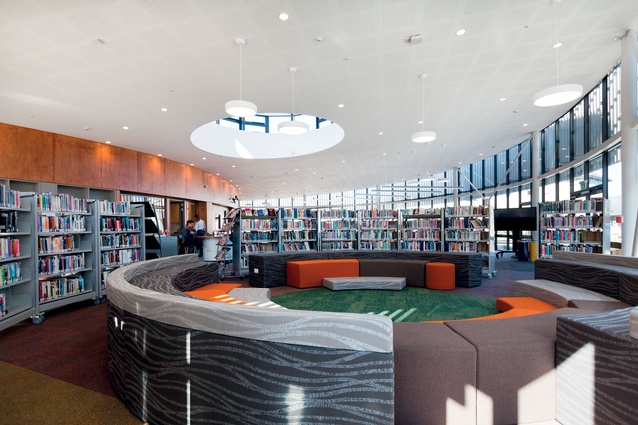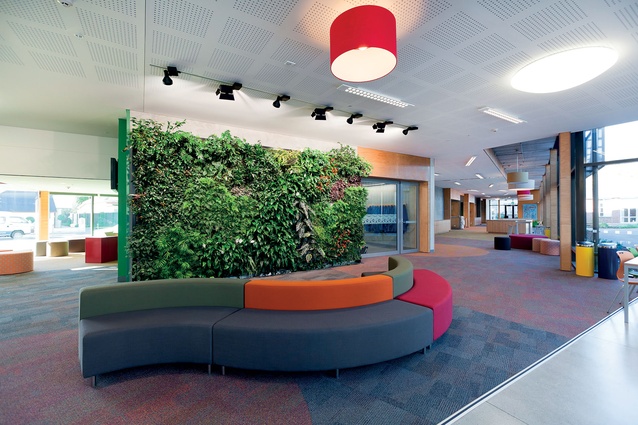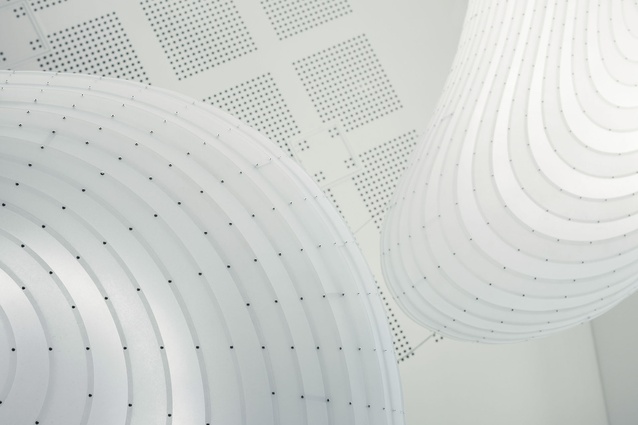Rangi Ruru Girls’ School
Students lounging around on multi-coloured chairs that can be reconfigured as desired; others opening windows to allow the building to self-ventilate or simply contemplating a bright-green living wall of plants: all are just as valid methods of learning as are those where students are sitting at desks, says Australian architect Craig Brown, a director of Melbourne-based McIldowie Partners Architects & Interior Designers.
The firm designed Rangi Ruru Girls’ School’s new Gibson Centre – a 590m2, single-storeyed library and function centre – and the Science Centre which encompasses classrooms and laboratories on 2110m2, spread through two levels. Both were built to replace earthquake-damaged buildings. The design of the Centres was influenced by an existing building on the site as well as by the surrounding natural environment of Canterbury. Exterior lines and detailing take their cues from the historic Tudoresque Te Koraha building, a large, two-storeyed timber house built between 1884 and 1886, which functions as the school’s administration block. Interior and exterior graphic concrete, with a grass-like pattern, brings a unique textural element to the design alluding to the Canterbury Plains. This theme is continued inside the buildings, in particular the Science Centre, with the lower floor reflecting the Plains. This theme moves up into the Southern Alps as students climb up the staircase to the second level past a stunning layer of David Trubridge ‘Cloud’ lights. The colour palette of earthier tones moving to blues and greys reinforces the theme.
Brown describes the Centre as “a living, breathing giant science experiment… It’s a living building.” He goes on to explain how the building will “actively engage” the students through its environmental components: “natural ventilation for both heating and cooling, digital displays, green walls and weather stations”.
The Centres feature flexible learning spaces, digital displays which can be incorporated into teaching (i.e. showing the building’s water use and solar power) and energy-efficient design. Exposing the services in the ceilings of the labs, plus the use of concrete slab walls and floors, offer heat exchange and help to stabilise the internal environment. Both buildings have been designed to maximise the use of natural light and ventilation via Canterbury’s prevailing winds.
“Air comes in low from the open windows on one side of the building, flows through the space then out the other side, tempered by the floor, ceiling and wall panels,” explains Terry Mason, another director of McIldowie Partners.
He describes the interior of the Gibson Centre as “the jewel in the crown” of the new academic precinct (by the end of this year, it is expected to include new student services, social sciences and art and technology faculty buildings). It is oval in shape; the soft curves and edges form part of a motif recurring on everything from seating to bookshelves. It gives the building a friendly, social feel, something that school principal, Julie Moor, says was one of the key considerations when planning the buildings in recognition of how important social experiences are in a girl’s life. As the school celebrates its 125th anniversary this year, many former students have returned for the celebrations, reinforcing the close lifelong friendships that can develop here, she says. Spaces for building friendships and positive social interactions have been interwoven into both buildings.
It could be argued that the interior of the Gibson Centre looks more like an upmarket café than a school library with a variety of seating options from comfy armchairs to high bar stools gathered around tables. The reading ‘pit’ is the main focal point of the room. Rather than sink the pit into the floor, to give more flexibility to the space, it is created by students as they shift around a series of curved seats that fit together like a jigsaw puzzle rising up to different levels. Original rimu flooring was salvaged from an earthquake-damaged building on the campus and has found new life after being made into the library’s main desk. The wooden patina has been replicated in feature wall panels.
The overall design of these two buildings, says Brown, reflects changes in pedagogy: “If students are comfortable, they’ll learn. Things like who their friends are and what they believe in are also important ways to learn more about themselves. The concept of enquiry-based learning means that it is as valid to be draped on a couch with an open laptop and an enquiring mind as it is to be behind a desk.”
















